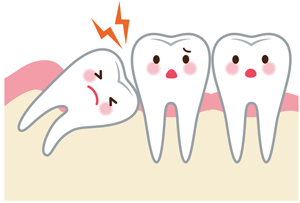There are several reasons a tooth may need to be extracted. A break, decay, a cavity, impaction, bone loss, periodontal disease and more could all create or contribute to a situation where removal of the tooth may be the most appropriate course of action. If that happens, there is really no cause to be alarmed. Dental extractions are among the most commonly performed dental procedures in the US. Educating yourself about the process may help it go more smoothly, though, and so we have put together a brief fact sheet for you:
- There are two different types of extraction: A “simple” extraction is an extraction that involves the minor expansion of the socket, the separation of the ligament that holds the tooth in the socket and the uncomplicated removal of the tooth using tools like extraction forceps.
“Surgical” tooth extractions come into play when some aspect of the tooth like positioning, shape, brittleness, etc. complicates the removal. Situations like impacted wisdom teeth, teeth with curved roots and teeth that have not erupted may all require surgical techniques to be extracted. - Regardless of the type of extraction, step 1 will be some sort of pain control: In a simple extraction, pain management will likely start with a topical anesthetic over the extraction site to prepare for an injection(s) to numb the tooth, bone and gum tissue. In a surgical extraction, things may be a little bit different. Depending on the patient and the surgeons preference, there are different options for anesthesia. In many cases, the patient may be given an intravenous sedative and local anesthesia to follow. Nitrous oxide gas is also a viable option. In extremely rare cases, the surgeon may choose to put the patient under general anesthesia before performing a surgical extraction.
- Expect to feel something: Let’s be clear, you should not feel pain. Quality dentists and oral surgeons take extra care to make sure their patients are as comfortable as possible for this procedure. That doesn’t mean you won’t feel anything. Even during surgical extractions where the patient is sedated, there is still sensation. Most commonly, patients report feeling pressure and tugging. Pressure and pain are transmitted by entirely different sets of nerves, and your pain sensors will have been “turned off” by the anesthesia. In some cases a patient may find that they are feeling pain. If this is the case it is important to let your dentist know so you can be given more anesthesia. However, it is important to be accurate when considering and reporting these sensations. More anesthetic will do nothing to take away the sensation of pressure and may, in fact, put you at greater risk for complications during and after your procedure.
- Sometimes you may hear things as well: This can be disconcerting for a patient who is not prepared. The sounds of the tools clicking against teeth, grinding and what may sound like cracking or breaking is not at all uncommon and in no way means anything is wrong or that the procedure is not going smoothly. Some dentists talk to their patients or find other ways to keep them distracted (like playing a movie during the procedure) and this is often enough of a distraction for the patient to not even notice the subtle sounds of the procedure.




